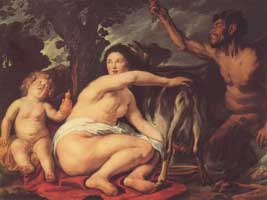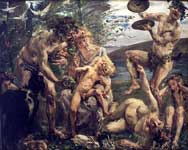.

In Greek mythology, Amalthea (Greek Αμαλθεια, "tender") is the most often mentioned among foster-mothers of Zeus. She is sometimes represented as the goat which suckled the infant-god in a cave in Mount Aigaion ("Goat Mountain") in Crete, sometimes as a goat-tending nymph of uncertain parentage (daughter of Oceanus, Haemonius, Olen, or Melisseus), who brought him up on the milk of a goat. In order that Cronus should not hear the wailing of the infant, Amalthea gathered about the cave the Kuretes or the Korybantes to dance and shout and clash their spears against their shields (Kerenyi 1951, p 94).
It is the early 4th-century AD Christian writer Lactantius (in Divine Institutions i.22), who asserts that the child was fed by Amalthea and Melissa, whom Lactantius takes to be the daughters of King Minos. There are earlier stories of the child Zeus being nourished by sacred bees.
The goat Amalthea's horn, according to the Alexandrian poet Callimachus (Hymn to Zeus) was the original of the drinking vessel called a rhyton, an inverted horn-shape in its most basic form, with an outlet hole in the pointed base— the very horn from which the child Zeus drank.
Alternatively, the sacred goat having broken off one of its horns, Amalthea filled it with flowers and fruits and presented it to Zeus, who placed it together with the goat amongst the stars, though the one-horned goat was not identified with the Unicorn by the Greeks. According to another story, Zeus himself broke off the horn and, in an example of mythic inversion, gave it to Amalthea, promising that it would supply whatever she desired in abundance. The goat-nymph, however, was older than the Olympian. Amalthea, in this tradition, gave it to the river-god Achelous (her reputed brother), who exchanged it for his own horn, which had been broken off in his contest with Heracles for the possession of Deianeira. According to ancient mythology, the owners of the horn were many and various. Speaking generally, it was regarded as the symbol of inexhaustible riches, the "horn of plenty" or Cornucopia, and became the attribute of various divinities— of Hades in his manifestation as Plouton, the bringer of wealth, of Gaia, Demeter, Cybele, and of rivers as fertilizers of the land.
The term "horn of Amalthea" is applied to a fertile district, and an estate belonging to Titus Pomponius Atticus was called Amaltheum. Cretan coins represent the infant Zeus being suckled by the goat; other Greek coins exhibit him suspended from its teats or carried in the arms of a nymph (Ovid, Fasti, v. 115; Metam. ix. 87).
Amalthea's skin, or that of her goat, killed and skinned by the grown Zeus, became the protective aegis in some traditions, a vivid enough metaphor for the transfer of power to the Olympian gods.
Amalthea's skin also became the aegis in some traditions.
See also
Asteroid 113 Amalthea
See also : Greek Mythology. Paintings, Drawings
| Ancient Greece
Science, Technology , Medicine , Warfare, , Biographies , Life , Cities/Places/Maps , Arts , Literature , Philosophy ,Olympics, Mythology , History , Images Medieval Greece / Byzantine Empire Science, Technology, Arts, , Warfare , Literature, Biographies, Icons, History Modern Greece Cities, Islands, Regions, Fauna/Flora ,Biographies , History , Warfare, Science/Technology, Literature, Music , Arts , Film/Actors , Sport , Fashion --- |
Retrieved from "http://en.wikipedia.org"
All text is available under the terms of the GNU Free Documentation License




